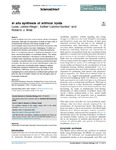Mostrar o rexistro simple do ítem
In Situ Synthesis of Artificial Lipids
| dc.contributor.author | Lomba-Riego, Lucía | |
| dc.contributor.author | Calviño Sanlés, Esther | |
| dc.contributor.author | Brea, Roberto J. | |
| dc.date.accessioned | 2023-01-12T16:35:04Z | |
| dc.date.available | 2023-01-12T16:35:04Z | |
| dc.date.issued | 2022-09-15 | |
| dc.identifier.citation | Lucia Lomba-Riego, Esther Calvino-Sanles, Roberto J. Brea, In situ synthesis of artificial lipids, Current Opinion in Chemical Biology, Volume 71, 2022, 102210, ISSN 1367-5931, https://doi.org/10.1016/j.cbpa.2022.102210. (https://www.sciencedirect.com/science/article/pii/S1367593122000953) | es_ES |
| dc.identifier.issn | 1367-5931 | |
| dc.identifier.uri | http://hdl.handle.net/2183/32338 | |
| dc.description | This review comes from a themed issue on Synthetic Biomolecules (2022); Edited by Neal K. Devaraj and Shinya Tsukiji | es_ES |
| dc.description | Financiado para publicación en acceso aberto: Universidade da Coruña/CISUG | es_ES |
| dc.description.abstract | [Abstract] Lipids constitute one of the most enigmatic family of biological molecules. Although the importance of lipids as basic units of compartmental structure and energy storage is well-acknowledged, deciphering the biosynthesis and precise roles of specific lipid species has been challenging. To better understand the structure and function of these biomolecules, there is a burgeoning interest in developing strategies to produce noncanonical lipids in a controlled manner. This review covers recent advances in the area of in situ generation of synthetic lipids. Specifically, we report several approaches that constitute a powerful toolbox for achieving noncanonical lipid synthesis. We describe how these methodologies enable the direct construction of synthetic lipids, helping to address fundamental questions related to the cell biology of lipid biosynthesis, trafficking, and signaling. We envision that highlighting the current advances in artificial lipid synthesis will pave the way for broader interest into this emerging class of biomimetic molecules. | es_ES |
| dc.description.sponsorship | Roberto J. Brea acknowledges support from Xunta de Galicia through the “Atracción de talento investigador” programme (ED431H2020/19). Roberto J. Brea also thanks the Agencia Estatal de Investigación (AEI) and the Ministerio de Ciencia e Innovación (MICINN) for his Ramón y Cajal contract (RYC2020-030065-I). The authors acknowledge funding for open access charge from Universidade da Coruña/Consorcio Interuniversitario de Galicia (CISUG) | es_ES |
| dc.description.sponsorship | Xunta de Galicia; ED431H2020/19 | es_ES |
| dc.language.iso | eng | es_ES |
| dc.publisher | Elsevier | es_ES |
| dc.relation | info:eu-repo/grantAgreement/AEI/Plan Estatal de Investigación Científica y Técnica y de Innovación 2017-2020/RYC2020-030065-I/ES/ | es_ES |
| dc.relation.uri | https://doi.org/10.1016/j.cbpa.2022.102210 | es_ES |
| dc.rights | Atribución-NoComercial-SinDerivadas 4.0 Internacional | es_ES |
| dc.rights.uri | http://creativecommons.org/licenses/by-nc-nd/4.0/ | * |
| dc.subject | Artificial lipid | es_ES |
| dc.subject | Phospholipid | es_ES |
| dc.subject | Glycolipid | es_ES |
| dc.subject | Chemoenzymatic | es_ES |
| dc.subject | Enzyme-free | es_ES |
| dc.title | In Situ Synthesis of Artificial Lipids | es_ES |
| dc.type | info:eu-repo/semantics/article | es_ES |
| dc.rights.access | info:eu-repo/semantics/openAccess | es_ES |
| UDC.journalTitle | Current Opinion in Chemical Biology | es_ES |
| UDC.volume | 71 | es_ES |
| UDC.issue | December 2022 | es_ES |
| UDC.startPage | 102210 | es_ES |
| dc.identifier.doi | 10.1016/j.cbpa.2022.102210 |






